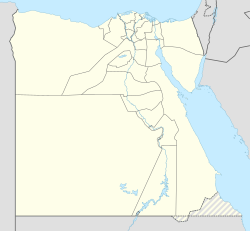
Summary
Dokki (Arabic: الدقي pronounced [ed.ˈdoʔ.ʔi], is one of nine districts that make up Giza city,[1] which is part of Greater Cairo, in Egypt. Dokki is situated on the western bank of the Nile, directly across from Downtown Cairo. It is a vital residential and commercial district with major roads connecting the two parts of Greater Cairo (Cairo and Giza).
Dokki
الدقي | |
|---|---|
District | |
 El-Dokki neighborhood borders | |
 Dokki Location in Egypt | |
| Coordinates: 30°02′17″N 31°12′40″E / 30.03806°N 31.21111°E | |
| Country | |
| Governorate | Giza Governorate |
| Time zone | UTC+2 (EST) |
History edit
Dokki used to be a village on a mostly royal and state-owned agricultural estate held under waqf (endowment) until the early 20th Century along with 'izbas (hamlets) such as Awlad 'Allam, Bein al-Sarayat and Dayr al-Nahya, surrounding the palace of princess Fatima, granddaughter of Khedieve Ismail.[2] A renewed and expanded bridge and a real estate boom saw the land on Cairo's western bank being sold to property developers and subdivided into new suburban villa neighbourhoods. One of these companies was Société Anonyme Immobiliere des Terrains de Giza & Rodah which acquired the land around what is today Midan Finney, and after initial bankruptcy in 1910, started developing the land under new owner, Oswald Finney, in the 1930s.[3] The Ministry of Awqaf was responsible for much of the urban sub-divisions in its northern part when its chief architect Mahmoud Riad planned Madinat al-Awqaf in 1948.
These developments and hamlets made up most of the Wasat (middle) district in the city of Giza,[4] before being divided in 1997 into the districts of Dokki (developments, hamlets and southern half of Madinat al-Awqaf, refletced in the names of the sub-districts, see Demographics below), and Agouza to the north with the northern half of Madinat al-Awqaf known colloquially today as Mohandessin.
A theory about its name is that the name originated from the Dokki family, which inhabited this region since ancient times and came to it from Upper Egypt and resided in it, then soon moved to the countryside in Menoufia.[citation needed]
Many Cairene landmarks are located in Dokki, the German school Deutsche Evangelische Oberschule Kairo (DEO)[5] and the embassies of many countries including Russia, Somalia, France, Chad, the Czech Republic, Pakistan, and Ethiopia. Dokki is home to approximately 56 foreign embassies, a number surpassed only by the Zamalek district. King Idris of Libya died at the Palace in Dokki in 1983.[6]
Demographics and sub-districts edit
In 2017, Dokki had a population of 70,926 people (35,750 male, 35,176 female).[7]
It is sub-divided into six shiakhas as follows:
| Shiakha | Code 2017 | Total Population | Male | Female |
|---|---|---|---|---|
| Sulaymân Jûhar | 210301 | 14661 | 7389 | 7272 |
| Madînat al-Awqâf | 210302 | 27567 | 13677 | 13890 |
| Dâyir al-Nâhya | 210303 | 6614 | 3356 | 3258 |
| Awlâd `Allâm | 210304 | 2284 | 1134 | 1150 |
| Bayn al-Sarâyât | 210305 | 9459 | 4919 | 4540 |
| Urmân, al- | 210306 | 10341 | 5275 | 5066 |
Education edit
The Dokki neighborhood is also called the "Schools District", where there are about 102 schools that represent all types of schools (government - private - experimental - languages). In addition to that, there is also [Deutsche Evangelische Oberschule]
- The Deutsche Evangelische Oberschule is located in Dokki.[9]
- The Pakistan International School of Cairo was formerly in Dokki.[10]
Transport edit
The Dokki district currently has 2 Cairo Metro stations (Bohooth & Dokki) both are parts of line 2. In addition to that 1 station from the under development line 3 will be on the Gameat Al Dewal Al Arabeya street between Dokki and Mohandiseen district Many public buses lines pass through it and it has a lot of station and on of the main working district for.
Business edit
Banks edit
Almost all banks in Egypt have one or more branches in the Dokki district. For example El Ahli bank has around 5 branches in the Dokki.
Legal edit
- Ibrachy & Dermarkar (1932)
Restaurants edit
The Dokki district contains varieties of food restaurant of different types: 1. for Shawerma there is Semsema, Naama, Shawerma Al Reem and many more. 2. almost all franchise american food have one or more than one branch there. for example McDonalds, Pizza hut, Papa John's, WeinerWald, Domino's Pizza and many more 3. Kebab restaurants: Radwan, Sheikh, Antar, Azma, Seikh mashwy and many more. 4. Kedba and sausage: for example Ezz El Menoufy.
The Dokki is a vital distract with many companies, schools, Embassies and banks.
See also edit
References edit
- ^ "الصفحة الرئيسية حى الدقى". www.giza.gov.eg. Retrieved 7 January 2023.
- ^ "'Izbit Awlād 'Allām - Tadamun". Retrieved 8 January 2023.
- ^ Raafat, Samir (2004). "Oswald Finney". www.egy.com. Retrieved 8 January 2023.
- ^ "الصفحة الرئيسية حى الدقى". www.giza.gov.eg. Retrieved 11 January 2023.
- ^ "Home".
- ^ Hosam, Othman. "System Audit Manager". Coca Cola Egypt. Retrieved 29 August 2011.
- ^ "2017 Census for Population". cedejcapmas.org. 2017. Retrieved 8 January 2023.
- ^ "2017 Census for Population". cedejcapmas.org. 2017. Retrieved 8 January 2023.
- ^ "Kontakt Archived 28 July 2017 at the Wayback Machine." Deutsche Evangelische Oberschule. Retrieved on 18 January 2015. "6, El Dokki St. Dokki / Giza"
- ^ "Contact Us." Pakistan International School Cairo. Retrieved on 21 April 2015. "12 Midan Tehran, Dokki, Cairo."
External links edit
- Dokki and Mohandiseen travel guide from Wikivoyage


